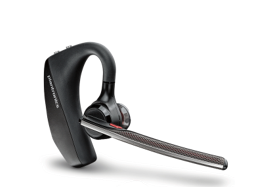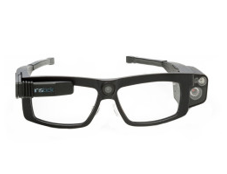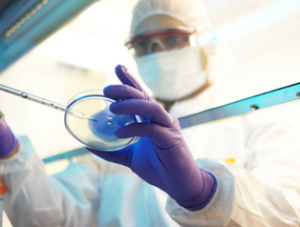Look Ma, No Hands! The Future of Hands-free Technology in the Lab
August 24, 2023

Hands-free technology has come a long way since Bluetooth headsets first appeared in 1999. Advancements in voice recognition and artificial intelligence are revolutionizing the way we interact with devices. Future advances in hands-free technology will bring exciting possibilities to various lab settings across every industry. In this blog post, we’ll look at how hands-free technology in the lab began, where it is today, and what it may do for the lab of the future.
Hands-Free Technology in the Lab
Historians believe that the first lab notes were those of Archimedes, who made notes and drawings about his mathematical and engineering discoveries on parchment. With the rise of remote work and the need for multitasking, hands-free technology has become an essential tool for productivity and efficiency in the modern workplace.
Lab notebooks of today are capable of storing photographic images, voice notes, and analyst’s locations, while interfacing with the other informatics systems in use in the lab and across the organization.
The hands-free communication tools that many lab analysts make use of today are based on Bluetooth and WiFi, which use radio frequencies to send signals short distances without wires. The frequency-hopping technology that keeps these signals secure is the invention of Hedy Lamarr. Although she is better known today for her starring roles in Hollywood films, Lamarr thought of herself as a scientist.
Current applications of Bluetooth and WiFi for hands-free applications in the lab include two main focuses:
- voice-activated virtual assistants based on voice recognition, and
- wearable devices.
If you employ Bluetooth-enabled devices in your lab and you have data privacy or security concerns, ensure that employees follow best practices and turn off Bluetooth when the devices are not in use, keep the software updated, and use antivirus programs.
Voice Recognition Software Applications in the Lab

Voice recognition software underpins the voice-activated virtual assistants that are the most familiar hands-free lab note-taking technology. The applications using voice recognition are constantly evolving and improving to meet the needs of scientists and researchers. Voice recognition software uses artificial intelligence to convert spoken words into text, using complex algorithms and machine learning to enhance accuracy and efficiency.
The two most common voice recognition software models are the hidden Markov model, which deconstructs words into their phonemes, and recurrent neural networks, which use outputs from prior steps to influence inputs to the current step. These models follow the GIGO principle, whereby gendered and racist assumptions within the training data find their way into the applications upon which they are based.
It is important to understand that the models used to train voice recognition software can perpetuate bias and can have difficulty recognizing the accents of non-native English speakers. LabTwin has worked to address these shortcomings in large language models (LLMs) by adding examples of speech from their multilingual team to their training data set.
The newest features and advancements in voice recognition software include improving machine learning models with natural language processing (upon which LabTwin relies), real-time transcription, and voice commands for data analysis. As you are no doubt aware, scientific language presents challenges to understanding even in your native tongue. Translating it among languages or recognizing it in accented speech adds additional complexity. However, the advantages in capturing experimental processes as they happen far outweigh the drawbacks. Scientists working in clean room environments or in the field, where their hands may be covered in PPE or occupied with other tools, benefit especially from these capabilities.
Wearable Devices for Hands-free Lab Environments

Wearable devices, like smartglasses and wristbands, offer a convenient and ergonomic way for scientists and researchers to access or collect information without using their hands. Smart glasses have become particularly useful for implementing standard operating procedures (SOPs) because each step is displayed in the user’s field of vision as the SOP is being implemented. This helps to ensure that no step is missed. Silicone wristbands can function as passive sampling devices, collecting information about air quality or the physiological condition of the wearer. Because a fully digitized lab may not be a fully automated one, these applications are increasingly useful. The benefits of wearable devices include improved mobility, real-time data visualization, and seamless integration with other lab equipment.
Hands-free Technology Integration with LIMS
The integration of hands-free lab notes with a laboratory information management system (LIMS) provides a comprehensive and streamlined approach to data management and analysis in the lab. Many LIMS now offer apps that can be used to add notes to records or check on results when the analyst is not at a terminal. In addition, third-party apps, such as SampleVision, can capture relevant sample information at the point of collection and transmit it seamlessly to the LIMS. Integration of these devices with LIMS provides some specific advantages.
Enhanced Data Accuracy and Traceability with Hands-free Technology
The integration of hands-free technology with LIMS ensures accurate and traceable data collection, reducing the risk of errors and facilitating reproducibility. Adding hands-free technology to your lab operations can increase data integrity. LabTwin, SampleVision, and other mobile devices for data capture are designed to integrate seamlessly with LIMS.
Improved Efficiency and Collaboration in the Lab with Hands-free Technology
Integrating hands-free lab note taking with laboratory informatics promotes efficient workflows, reduces contamination or waste, facilitates collaboration among researchers, and enables real-time data sharing. Configuring hands-free devices with your lab’s specific SOPs facilitates repeatability and the efficient use of materials.
The Future of Hands-free Technology in the Lab

Hands-free technology is revolutionizing the way scientists and researchers work in the lab, making their documentation more efficient and productive. Wearable devices and voice-activated assistants in the lab are increasing accuracy, enabling multitasking, reducing waste, and facilitating accessibility. These devices make labs better places to work for all kinds of people, providing individuals with disabilities greater access to scientific careers.
We have mentioned the potential security concerns with increased Bluetooth use and the difficulties of scientific language recognition. Additional challenges to the adoption of hands-free technology in the lab include compatibility issues and the learning curve for lab staff who adopt the new technology. These are not insurmountable problems, and applications of hands-free technology will continue to be found in the lab and in our daily lives. Future developments in hands-free applications will focus on real-time translation, augmented reality displays, haptic feedback, and better integrations with sensors and systems.
In what ways could your lab use hands-free technology?

